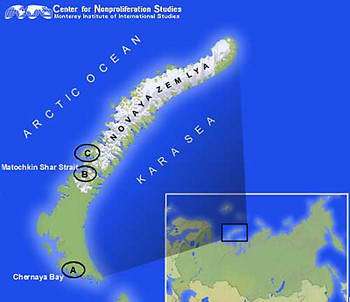Frozen in Time: A Cold War Relic Gives up its Secrets

Lying far above the Arctic Circle, the Russian archipelago of Novaya Zemlya is one of the most remote places on Earth, which is precisely why these mountainous, wind-swept islands were used as the Soviet Union’s main nuclear weapons test site from 1955 to 1990.
Image: Map courtesy of the Center for Nonproliferation Studies.
Since the end of the Cold War, a great deal of information about the former superpower's nuclear activities has become available. Combined with existing seismic records, this information enabled scientists at Lamont-Doherty Earth Observatory and the U.S. Geological Survey to conduct the most comprehensive study ever made of the extent of Soviet nuclear testing at Novaya Zemlya. Their findings appeared in a recent issue of the journal Science and Global Security.
According to the study, the Soviet Union conducted 130 underwater, atmospheric and underground nuclear tests at Novaya Zemlya over a period of 35 years, some of which involved multiple explosions. In all, 224 nuclear devices were detonated, amounting to 265 megatons of explosive energy. By comparison, all of the explosives detonated over the course of World War II, including the August 1945 detonations of two U.S. nuclear bombs over Japan, amounted to two megatons.
Co-author Paul Richards, a seismologist at Lamont-Doherty and a professor of seismology at Columbia University, says that one of the main goals of the study was to document the course of modern weapons development. "This is an extraordinary aspect of modern civilization," Richards says. "It’s what it took for the U.S.S.R. to become a nuclear superpower."
The researchers based their study on hundreds of Russian technical reports, mostly written between 1989 and 1992 during the time of glasnost and perestroika. In addition to the test explosions, they describe many other activities, including studies of the effects of radiation on animals and equipment. The material also documented the site’s history and development of the infrastructure at Novaya Zemlya, which had remained largely unknown until now.
Construction of the test site, including relocation of more than 500 members of the indigenous population, began in 1954 after the Soviet Union determined that its test site in Kazakhstan was too close to human settlements to carry out large nuclear explosions.
During the winter of 1954-1955, nearly 10,000 Soviet soldiers lived in tents on the tundra, despite 40-knot winds and the presence of polar bears on the islands. Richards was particularly struck by the substantial work the Soviets put into establishing and carrying out their testing program. "This [Soviet nuclear testing] represents the same kind of effort that went into building the Great Wall of China," says Richards, who specializes in the use of seismological networks to monitor compliance with the Comprehensive Nuclear-Test-Ban Treaty (CTBT) and has devoted much of his career to refining seismological monitoring techniques.
Between 1955 and 1962, six tests were conducted in the waters off Novaya Zemlya: three underwater, one at the ocean surface and two slightly above the water. Between 1957 and 1962, Soviet scientists shifted to atmospheric testing, setting off 85 nuclear explosions above a site on the northern island.
Following the implementation of the Limited Test Ban Treaty in 1963 (also known as the Atmospheric Test Ban Treaty), Novaya Zemlya was also the site of the Soviet Union's largest underground tests, the most powerful of which occurred on September 12, 1973 when four nuclear devices with a total yield of 4.2 megatons were detonated on the northern island. The explosion had a seismic magnitude of 6.97 and triggered an 80 million-ton rockslide that blocked two glacial streams and created a two kilometer-long lake.
Between 1964 and 1990, an additional 32 underground tests involving 128 separate nuclear explosive devices were conducted at a site near the northern tip of the southern island on the Matochkin Shar strait that separates the islands. The weapons were exploded in tunnels sometimes several kilometers in length, constructed in the frozen rock, making them the only nuclear tests ever conducted in such a geologic setting. Six more underground tests were conducted in shafts near the southern tip of the main island.
Underground testing at Novaya Zemlya peaked in the 1970s before the Threshold Test Ban Treaty of March 1976 took effect, which prohibited underground tests exceeding 150 kilotons. Tests during this period also caused accidental releases of significant radioactivity in 1969, 1973, and 1987, only two of which have been officially reported in Russia Federation documents, the researchers found.
Parts of Novaya Zemlya are still being used today for non-explosive nuclear experiments conducted by the Russian Federation, which signed the CTBT in 1996. But Richards believes that its history as the cradle of Soviet weapons testing still lingers today. "The only reason Russia has membership in the G-8 today is because of the effort the Soviet Union put into building its military," says Richards. "Without that effort, Russia today would be assessed more in terms of its per capita GDP, and thus would be more comparable to Bulgaria than to the rest of the G-8 nations."
Source: Lamont-Doherty Earth Observatory















